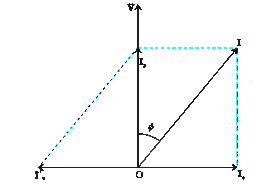(a) For circuits used for transporting electric power, a low power factor implies large power loss in transmission. Explain.
(b) Power factor can often be improved by the use of a capacitor of appropriate capacitance in the circuit. Explain.Solution in Kannada
(a) We know that P=IVcosϕ where cosϕ is the power factor. To supply a given power at a given voltage, if cosϕ is small, we have to increase current accordingly. But this will lead to large power loss (I2R) in transmission.
(b)Suppose in a circuit, current I lags the voltage by an angle ϕ. Then power factor cosϕ=R/Z.
We can improve the power factor (tending to 1) by making Z tend to R. Let us understand, with the help of a phasor diagram (Fig.) how this can be achieved. Let us resolve I into two components. Ip along

the applied voltage V and Iq perpendicular to the applied voltage. Iq as you have learnt in Section 7.7, is called the wattless component since corresponding to this component of current, there is no power loss. Ip is known as the power component because it is in phase with the voltage and corresponds to power loss in the circuit.
It’s clear from this analysis that if we want to improve power factor, we must completely neutralize the lagging wattless current Iq by an equal leading wattless current I.q. This can be done by connecting a capacitor of appropriate value in parallel so that Iq and I.q cancel each other and P is effectively IpV.
Similar Questions
a. For circuits used for transporting electric power, a low power factor implies large power loss in transmission. Explain.
b. Power factor can often be improved by the use of a capacitor of appropriate capacitance in the circuit. Explain.
View Solution(a) For circuits used for transporting electric power, a low power factor implies large power loss in transmission. Explain. (b) Power factor can often be improved by the use of a capacitor of appropriate capacitance in the circuit. Explain.
View Solution(a) For circuits used for transporting electric power, a low power factor implies large power loss in transmission. Explain.
(b) Power factor can often be improved by the use of a capacitor of appropriate capacitance in the circuit. Explain.
View Solution(a) For circuits used for transporting electric power, a low power factor implies larger power loss in transmission. Explain.
(b) power factor can oftern be improved by the use of a capacitor of appropraite capacitance in the circuit, Explain.
View SolutionFor circuits used for transporting electric power, a low power factor implies large power loss in transmission. Explain.
View SolutionPower factor can often be improved by the use of a capacitor of appropriate capacitance in the circuit. Explain.
View SolutionFor circuits used for transporting electric power , a low power factor implies a large power loss in transmittion. Why ?
View Solution

